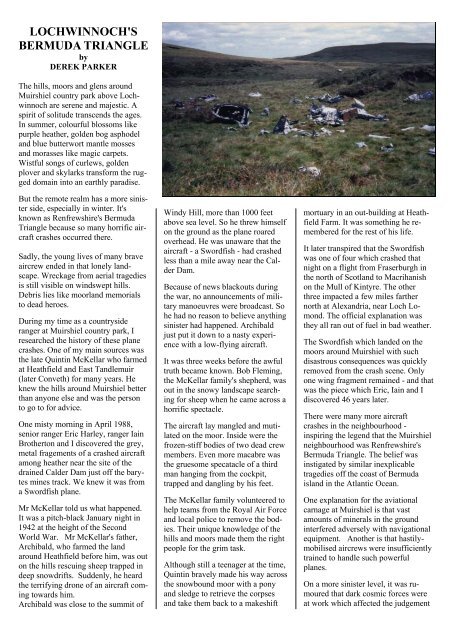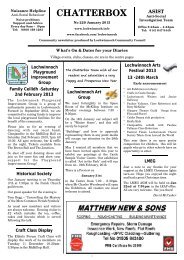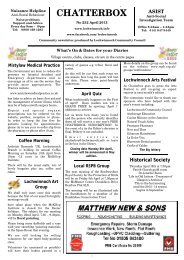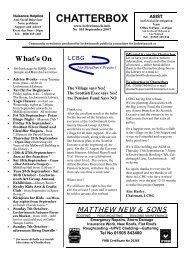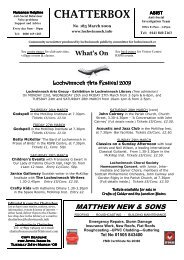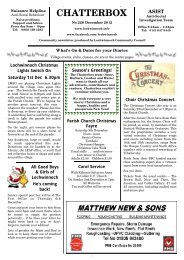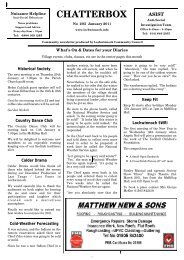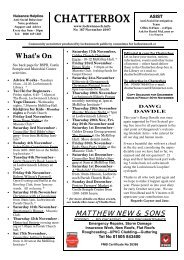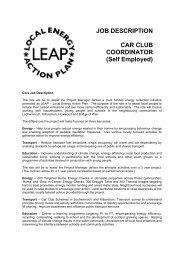CHATTERBOX - Lochwinnoch
CHATTERBOX - Lochwinnoch
CHATTERBOX - Lochwinnoch
Create successful ePaper yourself
Turn your PDF publications into a flip-book with our unique Google optimized e-Paper software.
LOCHWINNOCH'S<br />
BERMUDA TRIANGLE<br />
by<br />
DEREK PARKER<br />
The hills, moors and glens around<br />
Muirshiel country park above <strong>Lochwinnoch</strong><br />
are serene and majestic. A<br />
spirit of solitude transcends the ages.<br />
In summer, colourful blossoms like<br />
purple heather, golden bog asphodel<br />
and blue butterwort mantle mosses<br />
and morasses like magic carpets.<br />
Wistful songs of curlews, golden<br />
plover and skylarks transform the rugged<br />
domain into an earthly paradise.<br />
But the remote realm has a more sinister<br />
side, especially in winter. It's<br />
known as Renfrewshire's Bermuda<br />
Triangle because so many horrific aircraft<br />
crashes occurred there.<br />
Sadly, the young lives of many brave<br />
aircrew ended in that lonely landscape.<br />
Wreckage from aerial tragedies<br />
is still visible on windswept hills.<br />
Debris lies like moorland memorials<br />
to dead heroes.<br />
During my time as a countryside<br />
ranger at Muirshiel country park, I<br />
researched the history of these plane<br />
crashes. One of my main sources was<br />
the late Quintin McKellar who farmed<br />
at Heathfield and East Tandlemuir<br />
(later Conveth) for many years. He<br />
knew the hills around Muirshiel better<br />
than anyone else and was the person<br />
to go to for advice.<br />
One misty morning in April 1988,<br />
senior ranger Eric Harley, ranger Iain<br />
Brotherton and I discovered the grey,<br />
metal fragements of a crashed aircraft<br />
among heather near the site of the<br />
drained Calder Dam just off the barytes<br />
mines track. We knew it was from<br />
a Swordfish plane.<br />
Mr McKellar told us what happened.<br />
It was a pitch-black January night in<br />
1942 at the height of the Second<br />
World War. Mr McKellar's father,<br />
Archibald, who farmed the land<br />
around Heathfield before him, was out<br />
on the hills rescuing sheep trapped in<br />
deep snowdrifts. Suddenly, he heard<br />
the terrifying drone of an aircraft coming<br />
towards him.<br />
Archibald was close to the summit of<br />
Windy Hill, more than 1000 feet<br />
above sea level. So he threw himself<br />
on the ground as the plane roared<br />
overhead. He was unaware that the<br />
aircraft - a Swordfish - had crashed<br />
less than a mile away near the Calder<br />
Dam.<br />
Because of news blackouts during<br />
the war, no announcements of military<br />
manoeuvres were broadcast. So<br />
he had no reason to believe anything<br />
sinister had happened. Archibald<br />
just put it down to a nasty experience<br />
with a low-flying aircraft.<br />
It was three weeks before the awful<br />
truth became known. Bob Fleming,<br />
the McKellar family's shepherd, was<br />
out in the snowy landscape searching<br />
for sheep when he came across a<br />
horrific spectacle.<br />
The aircraft lay mangled and mutilated<br />
on the moor. Inside were the<br />
frozen-stiff bodies of two dead crew<br />
members. Even more macabre was<br />
the gruesome specatacle of a third<br />
man hanging from the cockpit,<br />
trapped and dangling by his feet.<br />
The McKellar family volunteered to<br />
help teams from the Royal Air Force<br />
and local police to remove the bodies.<br />
Their unique knowledge of the<br />
hills and moors made them the right<br />
people for the grim task.<br />
Although still a teenager at the time,<br />
Quintin bravely made his way across<br />
the snowbound moor with a pony<br />
and sledge to retrieve the corpses<br />
and take them back to a makeshift<br />
mortuary in an out-building at Heathfield<br />
Farm. It was something he remembered<br />
for the rest of his life.<br />
It later transpired that the Swordfish<br />
was one of four which crashed that<br />
night on a flight from Fraserburgh in<br />
the north of Scotland to Macrihanish<br />
on the Mull of Kintyre. The other<br />
three impacted a few miles farther<br />
north at Alexandria, near Loch Lomond.<br />
The official explanation was<br />
they all ran out of fuel in bad weather.<br />
The Swordfish which landed on the<br />
moors around Muirshiel with such<br />
disastrous consequences was quickly<br />
removed from the crash scene. Only<br />
one wing fragment remained - and that<br />
was the piece which Eric, Iain and I<br />
discovered 46 years later.<br />
There were many more aircraft<br />
crashes in the neighbourhood -<br />
inspiring the legend that the Muirshiel<br />
neighbourhood was Renfrewshire's<br />
Bermuda Triangle. The belief was<br />
instigated by similar inexplicable<br />
tragedies off the coast of Bermuda<br />
island in the Atlantic Ocean.<br />
One explanation for the aviational<br />
carnage at Muirshiel is that vast<br />
amounts of minerals in the ground<br />
interfered adversely with navigational<br />
equipment. Another is that hastilymobilised<br />
aircrews were insufficiently<br />
trained to handle such powerful<br />
planes.<br />
On a more sinister level, it was rumoured<br />
that dark cosmic forces were<br />
at work which affected the judgement


